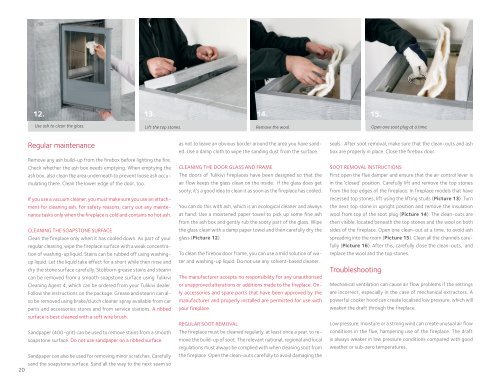ENG - Tulikivi
ENG - Tulikivi
ENG - Tulikivi
You also want an ePaper? Increase the reach of your titles
YUMPU automatically turns print PDFs into web optimized ePapers that Google loves.
12. 13.<br />
14.<br />
Use ash to clean the glass.<br />
Regular maintenance<br />
Lift the top stones.<br />
Remove any ash build-up from the firebox before lighting the fire.<br />
check whether the ash box needs emptying. When emptying the<br />
ash box, also clean the area underneath to prevent loose ash accumulating<br />
there. clean the lower edge of the door, too.<br />
If you use a vacuum cleaner, you must make sure you use an attachment<br />
for cleaning ash. For safety reasons, carry out any maintenance<br />
tasks only when the fireplace is cold and contains no hot ash.<br />
cLEANING THE SOAPSTONE SURFAcE<br />
clean the fireplace only when it has cooled down. As part of your<br />
regular cleaning, wipe the fireplace surface with a weak concentration<br />
of washing-up liquid. Stains can be rubbed off using washingup<br />
liquid. Let the liquid take effect for a short while then rinse and<br />
dry the stone surface carefully. Stubborn grease stains and stearin<br />
can be removed from a smooth soapstone surface using <strong>Tulikivi</strong><br />
cleaning Agent 4, which can be ordered from your <strong>Tulikivi</strong> dealer.<br />
Follow the instructions on the package. Grease and stearin can also<br />
be removed using brake/clutch cleaner spray available from car<br />
parts and accessories stores and from service stations. A ribbed<br />
surface is best cleaned with a soft wire brush.<br />
Sandpaper (400-grit) can be used to remove stains from a smooth<br />
soapstone surface. do not use sandpaper on a ribbed surface.<br />
Sandpaper can also be used for removing minor scratches. carefully<br />
sand the soapstone surface. Sand all the way to the next seam so<br />
20<br />
Remove the wool.<br />
as not to leave an obvious border around the area you have sanded.<br />
Use a damp cloth to wipe the sanding dust from the surface.<br />
cLEANING THE dOOR GLASS ANd FRAME<br />
The doors of <strong>Tulikivi</strong> fireplaces have been designed so that the<br />
air flow keeps the glass clean on the inside. If the glass does get<br />
sooty, it’s a good idea to clean it as soon as the fireplace has cooled.<br />
You can do this with ash, which is an ecological cleaner and always<br />
at hand. Use a moistened paper towel to pick up some fine ash<br />
from the ash box and gently rub the sooty part of the glass. Wipe<br />
the glass clean with a damp paper towel and then carefully dry the<br />
glass (Picture 12).<br />
To clean the firebox door frame, you can use a mild solution of water<br />
and washing-up liquid. do not use any solvent-based cleaner.<br />
The manufacturer accepts no responsibility for any unauthorised<br />
or unapproved alterations or additions made to the fireplace. Only<br />
accessories and spare parts that have been approved by the<br />
manufacturer and properly installed are permitted for use with<br />
your fireplace.<br />
REGULAR SOOT REMOVAL<br />
The fireplace must be cleaned regularly, at least once a year, to remove<br />
the build-up of soot. The relevant national, regional and local<br />
regulations must always be complied with when cleaning soot from<br />
the fireplace. Open the clean-outs carefully to avoid damaging the<br />
5.<br />
15.<br />
5.<br />
Open one soot plug at a time.<br />
seals. After soot removal, make sure that the clean-outs and ash<br />
box are properly in place. close the firebox door.<br />
SOOT REMOVAL INSTRUcTIONS<br />
First open the flue damper and ensure that the air control lever is<br />
in the ‘closed’ position. carefully lift and remove the top stones<br />
from the top edges of the fireplace. In fireplace models that have<br />
recessed top stones, lift using the lifting studs (Picture 13). Turn<br />
the next top stone in upright position and remove the insulation<br />
wool from top of the soot plug (Picture 14). The clean-outs are<br />
then visible, located beneath the top stones and the wool on both<br />
sides of the fireplace. Open one clean-out at a time, to avoid ash<br />
spreading into the room (Picture 15). clean all the channels carefully<br />
(Picture 16). After this, carefully close the clean-outs, and<br />
replace the wool and the top stones.<br />
Troubleshooting<br />
Mechanical ventilation can cause air flow problems if the settings<br />
are incorrect, especially in the case of mechanical extractors. A<br />
powerful cooker hood can create localised low pressure, which will<br />
weaken the draft through the fireplace.<br />
Low pressure, moisture or a strong wind can create unusual air flow<br />
conditions in the flue, hampering use of the fireplace. The draft<br />
is always weaker in low pressure conditions compared with good<br />
weather or sub-zero temperatures.







